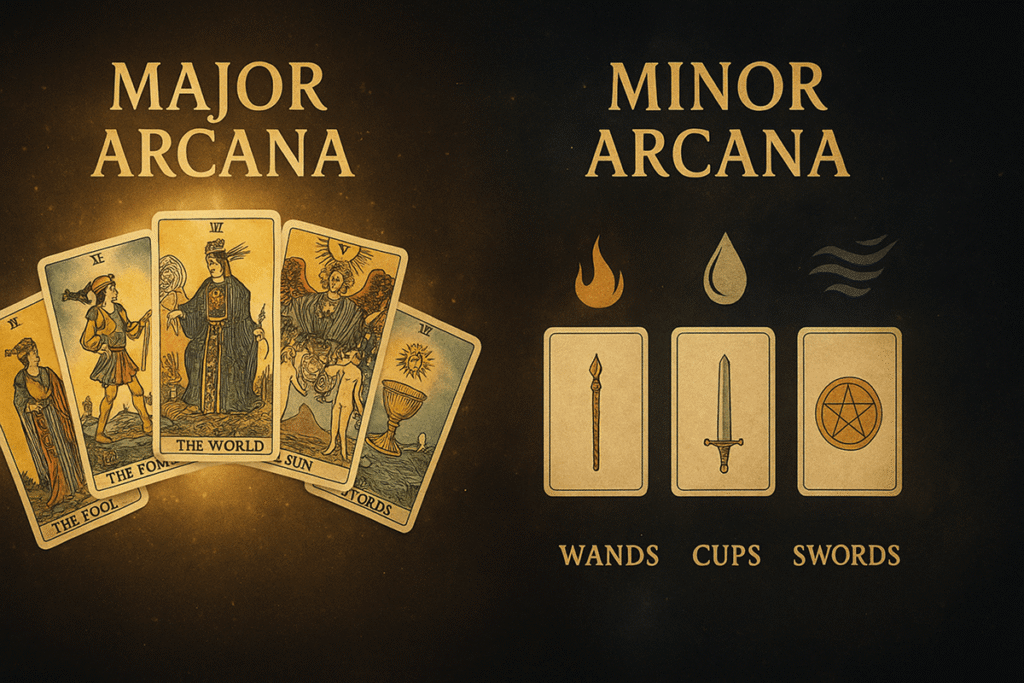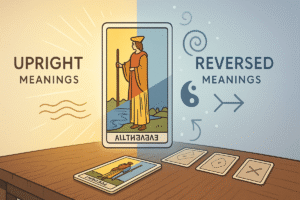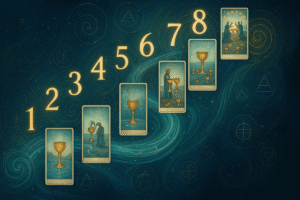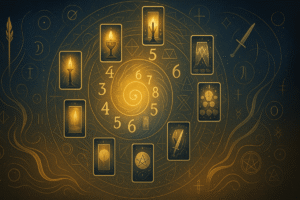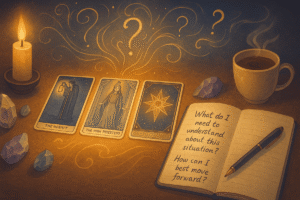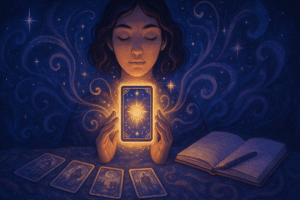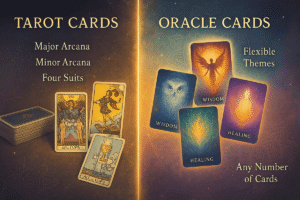Table of Contents
When I first picked up a tarot deck, I remember feeling overwhelmed by the sheer number of cards. Seventy-eight cards seemed like an intimidating collection of symbols and meanings to memorize. Perhaps you’ve felt this way too when starting your tarot journey. The good news is that understanding the basic structure of your deck can make the whole experience feel much more approachable and meaningful.
The foundation of any tarot deck lies in its division into two main sections: the Major Arcana and the Minor Arcana. Think of this structure as the backbone of your tarot practice. Once you grasp how these two parts work together, you’ll find that each reading becomes a more nuanced conversation with yourself about the various layers of experience in your life.
What Makes the Major Arcana Special
The Major Arcana consists of twenty-two cards, each one representing what many consider to be significant life themes or archetypal experiences. These cards have names like The Fool, Death, The Sun, and The World. When I encounter a Major Arcana card in a reading, I often pause for a moment longer than usual. There’s something about these cards that feels weightier, more significant perhaps.
These cards invite you to reflect on the bigger picture of your life journey. They might prompt you to consider questions like: What major themes are currently playing out in your life? Where do you find yourself in terms of personal growth or spiritual development? The Major Arcana doesn’t tell you what will happen, but rather encourages you to think about the deeper currents flowing through your experiences.
The imagery in Major Arcana cards tends to be rich with symbolism. The Tower shows a structure being struck by lightning, which might lead you to reflect on what foundations in your life feel unstable. The Star depicts a figure pouring water under a starlit sky, possibly encouraging thoughts about hope and renewal during difficult times. I find that these visual metaphors work best when they prompt personal reflection rather than providing definitive interpretations.
One thing I’ve noticed over time is that Major Arcana cards often appear when I’m grappling with questions that feel particularly meaningful or transformative. They seem to show up during periods of transition or when I’m wrestling with concepts that go beyond day-to-day concerns. This doesn’t mean they predict major life changes, but they do encourage deeper contemplation about where you are in your personal journey.
Understanding the Minor Arcana Structure
The Minor Arcana makes up the remaining fifty-six cards in your deck, and honestly, this is where things get more detailed and nuanced. These cards are organized into four suits, much like a regular playing card deck. You’ll find Cups, Pentacles (sometimes called Coins), Wands (or Rods), and Swords. Each suit contains fourteen cards, from Ace through Ten, plus four court cards.
What I find fascinating about the Minor Arcana is how it mirrors the complexity of daily life. While Major Arcana cards might prompt reflection on life’s big themes, Minor Arcana cards often relate to the practical, emotional, and interpersonal aspects of your everyday experience. They’re like the details that fill in the broader picture painted by the Major Arcana.
Each suit carries its own thematic focus, though I should mention that different readers interpret these themes in various ways. Cups generally relate to emotions, relationships, and intuitive experiences. When I draw a Cup card, I might ask myself: How am I feeling about my relationships right now? What emotional patterns am I noticing in my life?
Pentacles typically connect to material concerns, work, and practical matters. A Pentacles card might prompt questions like: How do I feel about my current projects or responsibilities? What does security mean to me right now?
Wands often relate to creativity, passion, and personal energy. They might encourage reflection on questions such as: What inspires me lately? Where do I feel most motivated or enthusiastic?
Swords frequently connect to thoughts, communication, and mental challenges. These cards might lead you to consider: What thoughts have been occupying my mind? How am I processing the challenges I’m facing?
The Court Cards Add Another Layer
Within each Minor Arcana suit, you’ll find four court cards: Page, Knight, Queen, and King. I’ll admit, these were probably the most challenging cards for me to understand when I was starting out. They seem to exist in this interesting space between representing aspects of personality and different approaches to the suit’s themes.
Some people interpret court cards as representing actual people in their lives, while others see them as different facets of their own personality or various approaches they might take to a situation. I’ve found both perspectives useful at different times. A Queen of Cups might prompt you to reflect on your nurturing side, while a Knight of Swords might encourage you to consider whether you’re being too hasty in your thinking.
The beauty of court cards lies in their flexibility. They invite you to explore different roles you play or might play in your life. Are you being the wise counselor today, like a King of Cups? Or perhaps you’re embracing the enthusiastic energy of a Page of Wands? These cards encourage self-awareness about the different aspects of your personality and how you show up in various situations.
How Major and Minor Arcana Work Together
Here’s where things get really interesting, at least in my experience. When you draw cards from both the Major and Minor Arcana in a single reading, they create layers of meaning that complement each other beautifully. The Major Arcana might point to the overarching theme or lesson, while the Minor Arcana provides the practical details or emotional context.
For example, you might draw The Hermit from the Major Arcana alongside the Four of Cups from the Minor Arcana. The Hermit could encourage reflection on your need for introspection or soul-searching, while the Four of Cups might prompt you to consider what opportunities you might be overlooking during this introspective period. Neither card tells you what to do, but together they create a richer framework for self-reflection.
I think this interplay between the arcanas is what makes tarot such a nuanced tool for contemplation. The Major Arcana provides the broad strokes, the big themes worth pondering. The Minor Arcana fills in the details, helping you connect those larger concepts to the specific circumstances and feelings in your daily life.
Practical Tips for Working with Both Arcanas
When you’re learning to work with your deck, you might find it helpful to notice which types of cards appear more frequently in your readings. Sometimes I go through periods where I seem to draw mostly Minor Arcana cards, which often coincides with times when I’m focused on day-to-day concerns and practical matters. Other times, Major Arcana cards appear more often, usually when I’m in a phase of deeper questioning or transition.
There’s no right or wrong balance between the two types of cards. Your deck will offer whatever combination feels most relevant for your reflection at any given time. I’ve learned to trust this process rather than trying to force a particular outcome.
One approach that has served me well is to pay attention to the overall energy of a reading. Are the cards mostly from one arcana or the other? What might that suggest about where your attention needs to be right now? A reading heavy in Major Arcana might indicate it’s time for bigger-picture thinking, while lots of Minor Arcana cards might suggest focusing on immediate concerns and relationships.
Creating Your Own Relationship with the Structure
Perhaps most importantly, remember that understanding the major vs minor arcana structure is just the beginning of your relationship with tarot. The real value comes from how you use this framework to facilitate your own self-reflection and personal growth. These categories provide a useful way to organize your thinking, but they shouldn’t limit your intuitive responses to the cards.
I encourage you to spend time with your deck and notice what patterns emerge for you personally. Do certain suits resonate more strongly with your life circumstances? Which Major Arcana cards feel most relevant to your current journey? There’s no need to memorize traditional meanings if a card speaks to you in a different way.
The structure of major and minor arcana gives you a roadmap, but the destination is always your own deeper understanding of yourself and your experiences. Each time you sit with your cards, you’re engaging in a form of guided self-reflection that can offer insights, clarity, and new perspectives on the questions that matter most to you.
Your tarot deck is ultimately a tool for contemplation and self-discovery. Understanding its structure simply helps you use that tool more effectively, creating space for the kind of thoughtful reflection that can enrich your daily life and personal growth journey.
Frequently Asked Questions
Are Major Arcana cards more important than Minor Arcana cards?
Not necessarily, though the names might suggest otherwise. While Major Arcana cards often feel weightier and relate to bigger life themes, Minor Arcana cards are equally valuable because they address the everyday experiences that make up most of our lives. Think of it this way: the Major Arcana provides the headline, but the Minor Arcana tells you what’s actually happening day to day. Both types of insight matter when you’re reflecting on your life. A reading with mostly Minor Arcana cards simply means you’re working through practical matters that are within your influence right now.
What does it mean when I draw mostly Major Arcana cards in a reading?
When several Major Arcana cards appear together, it often suggests you’re in a period where larger themes or significant transitions are at play in your life. These readings tend to feel more intense or meaningful. You might be grappling with bigger questions about your direction, identity, or purpose. However, this doesn’t predict specific outcomes. Rather, it invites you to reflect more deeply on the overarching patterns in your life right now. What major themes keep showing up for you? What feels particularly significant or transformative at this moment?
Should beginners start by learning the Major Arcana first?
Many people find this approach helpful because there are only twenty two Major Arcana cards compared to fifty six Minor Arcana cards. The Major Arcana also tends to be more intuitive since the imagery is often rich with recognizable archetypes and symbols. Starting with these cards can give you a solid foundation before diving into the more detailed Minor Arcana suits. That said, there’s no wrong way to learn. Some people prefer to explore the entire deck together, while others like to learn one suit at a time. Follow whatever approach feels most natural for your learning style.
Can I use only Major Arcana cards for readings?
Absolutely. Some people regularly work with just the Major Arcana, especially when they want to focus on bigger picture questions or life themes without getting into day to day details. You can separate the Major Arcana from your deck and use them on their own for reflective practices. This approach can be particularly useful when you’re contemplating significant life questions or seeking perspective on overarching patterns. The concentrated focus on archetypal themes can sometimes provide clarity that gets diluted in larger spreads.

